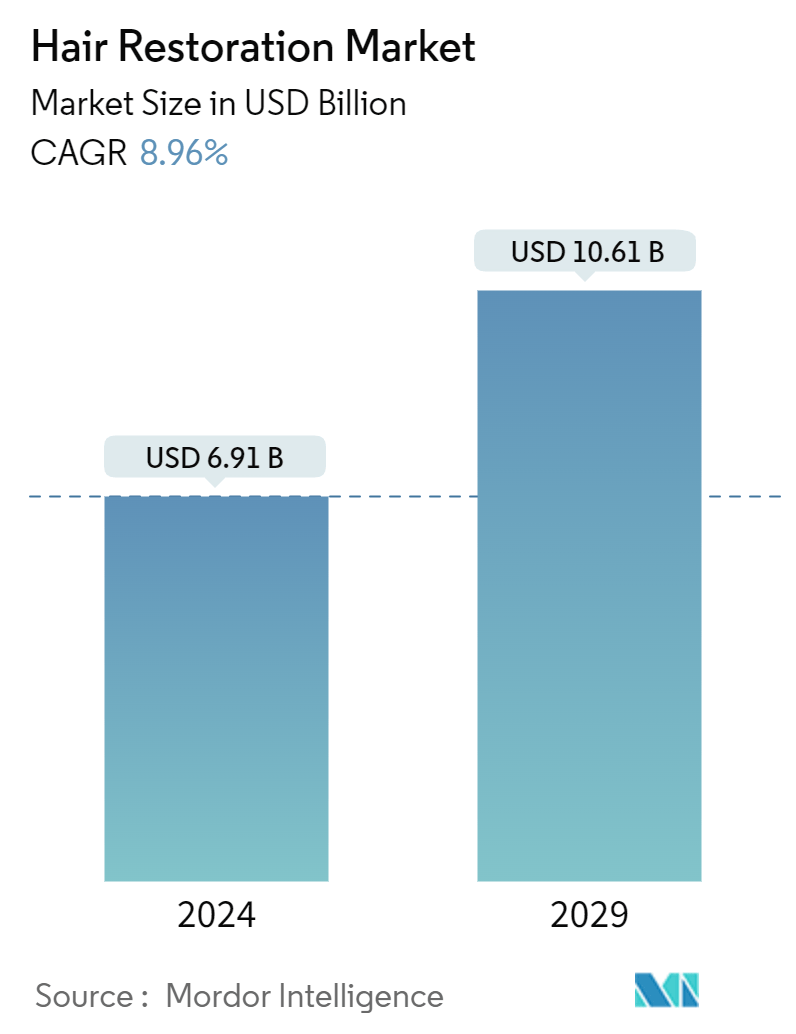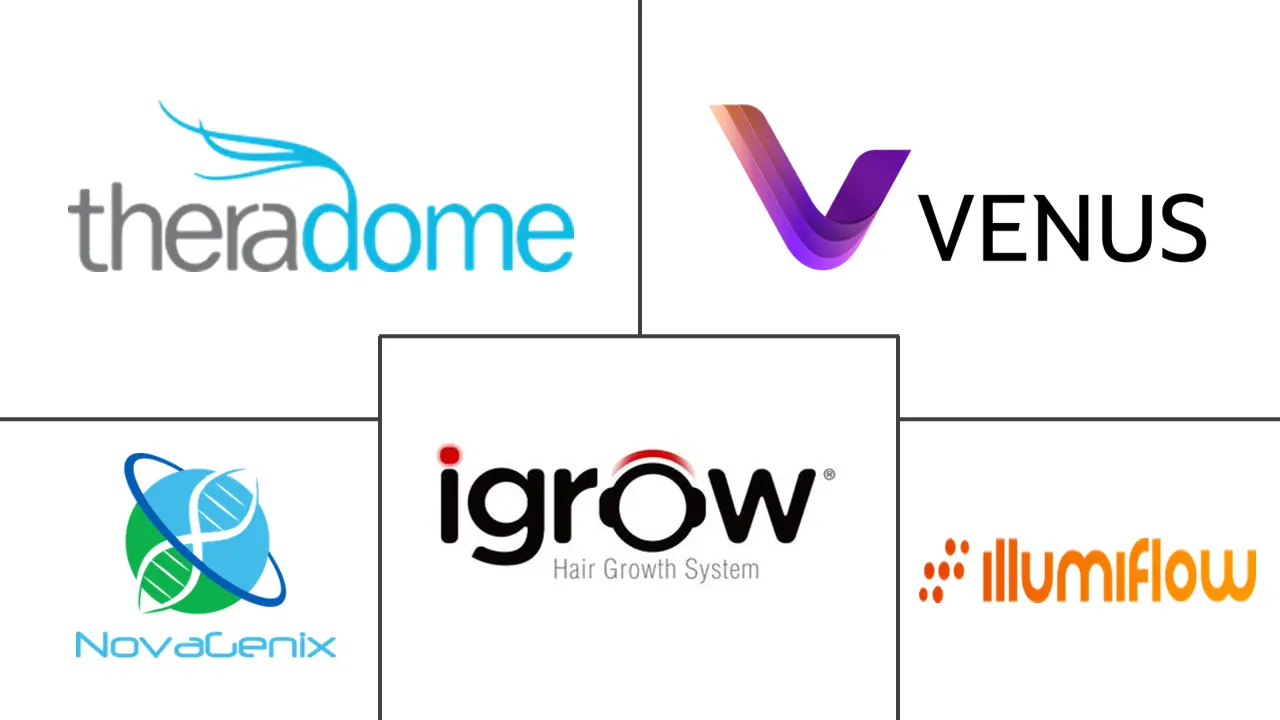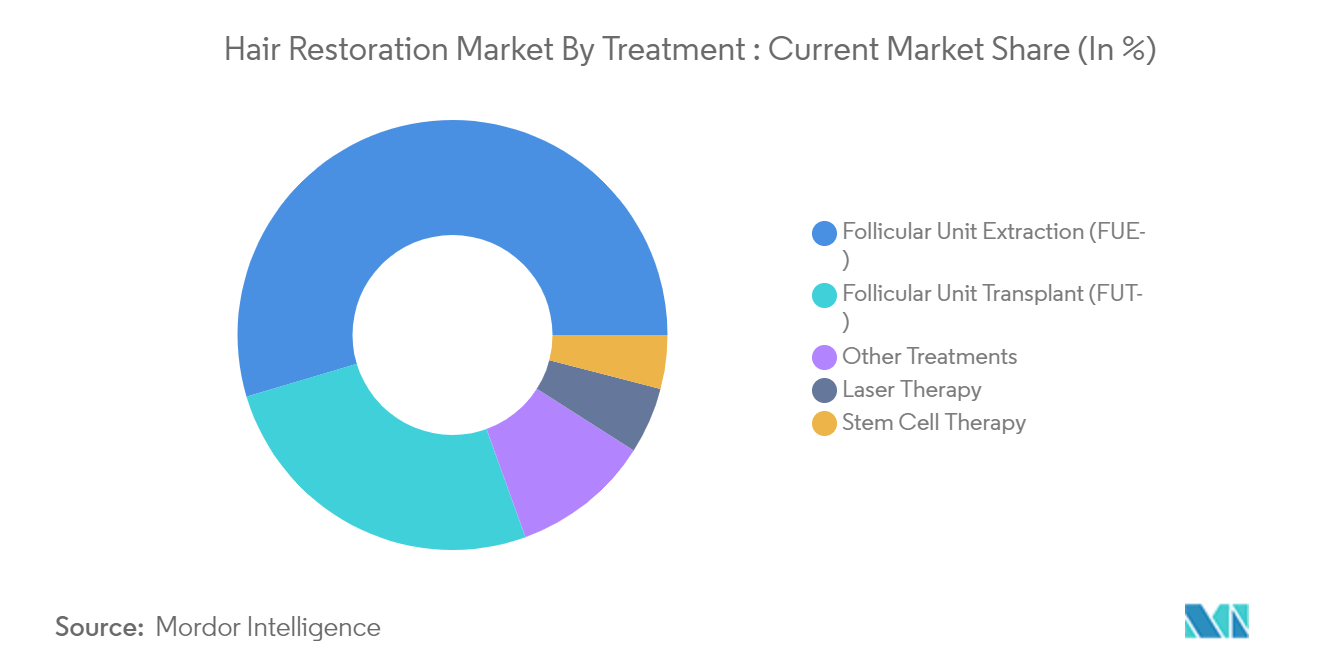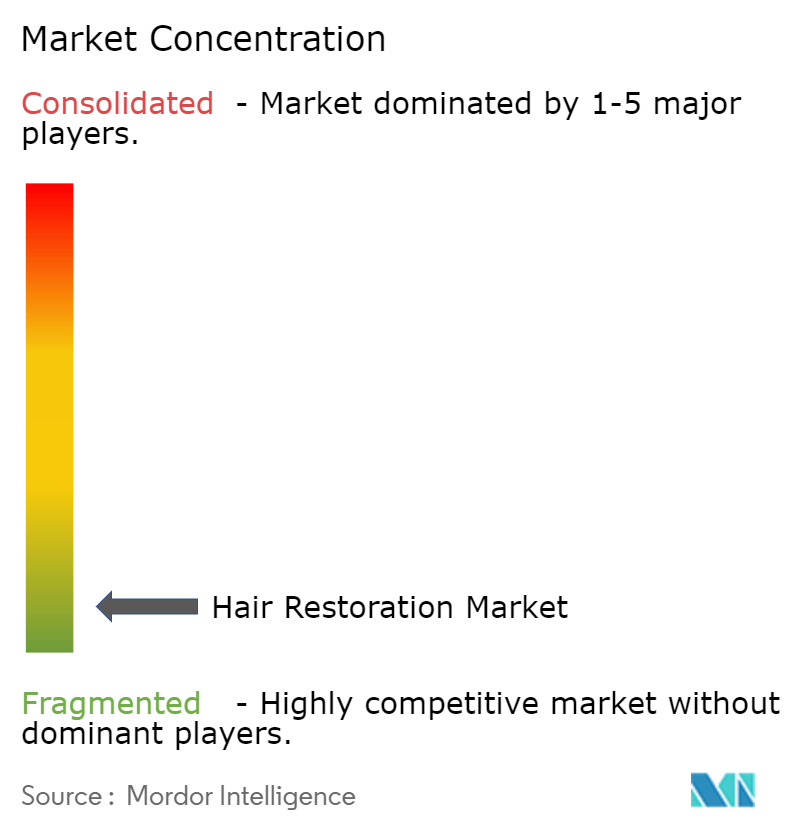Hair Restoration Services Market Size

| Study Period | 2019 - 2029 |
| Market Size (2024) | USD 6.91 Billion |
| Market Size (2029) | USD 10.61 Billion |
| CAGR (2024 - 2029) | 8.96 % |
| Fastest Growing Market | Asia Pacific |
| Largest Market | North America |
Major Players
*Disclaimer: Major Players sorted in no particular order |
Hair Restoration Services Market Analysis
The Hair Restoration Market size is estimated at USD 6.91 billion in 2024, and is expected to reach USD 10.61 billion by 2029, at a CAGR of 8.96% during the forecast period (2024-2029).
The Hair Restoration Market is experiencing significant growth, driven by two fundamental megatrends: the increasing popularity of hair restoration procedures and the rising prevalence of dermatological disorders leading to hair loss. These trends are reshaping the landscape of cosmetic and medical interventions, as more individuals seek effective solutions for hair loss and baldness.
Increasing Popularity Of Hair Restoration
The surge in popularity of hair restoration procedures is a key driver propelling market growth. Hair transplantation, in particular, has emerged as one of the most sought-after cosmetic procedures for men worldwide. This trend is fueled by several factors.
Growing demand is evident from an analysis by the International Society of Hair Restoration Surgery (ISHRS), which suggests that more than 700,000 hair transplant procedures are performed globally every year—more than 2.5 times the number at the start of the previous decade. This substantial increase reflects the rising acceptance and demand for hair transplant market solutions. Technological advancements have played a crucial role in this growing popularity. The introduction of innovative techniques such as robotics, platelet-rich plasma (PRP) therapy for hair loss, and photobiomodulation has revolutionized hair restoration technologies. These minimally invasive techniques offer reduced scarring, faster healing times, and improved outcomes, making them more appealing to patients.
The widespread prevalence of hair loss contributes significantly to the market's expansion. Hair loss affects a substantial portion of the global population, with 85% of males and 40% of females experiencing some form of hair loss during their lifetime. This widespread issue creates a large potential market for hair restoration services. Regional growth patterns also highlight the increasing popularity of these procedures. The Asia-Pacific region leads in the number of surgical procedures performed, followed closely by the Middle East/Africa and North America. Europe has also seen a notable increase in these procedures, indicating growing acceptance across different geographical regions.
Increasing Prevalence Of Dermatological Disorders Leading To Hair Loss
The rising incidence of various dermatological conditions resulting in hair loss is another significant driver for the hair restoration market. This trend is characterized by diverse hair loss conditions, including anagen effluvium, telogen effluvium, and androgenetic alopecia. The prevalence of these conditions contributes to the growing demand for hair loss treatment market solutions.
Gender-specific patterns play a crucial role in market dynamics. Androgenetic alopecia, the most common form of hair loss, affects approximately 50% of men and 15% of women. This high prevalence, particularly among men, creates a substantial market for hair restoration solutions. Age-related factors further amplify this trend. The likelihood of hair loss increases with age, with about 40% of men experiencing visible hair loss by age 35, rising to 65% by age 60. For women, the statistics are equally significant, with 40% suffering from hair loss by age 40, increasing to 80% by age 60.
The global impact of hair loss cannot be overstated. Over 147 million people worldwide suffer from alopecia, making it a truly global issue. This widespread prevalence across different ethnicities and regions contributes to the expanding market for hair restoration clinics. The psychological impact of hair loss is a crucial factor driving market growth. Studies have shown that 29% of women report symptoms of depression related to their hair loss. This emotional aspect drives many individuals to seek hair regrowth products, further fueling market expansion.
The convergence of these two major drivers—the increasing popularity of hair restoration procedures and the rising prevalence of dermatological disorders causing hair loss—creates a robust foundation for the continued expansion of the Hair Restoration Market. As technological advancements continue and awareness grows, the market is poised for sustained growth in the coming years. The combination of medical necessity and cosmetic desire, coupled with improving treatment options, ensures that the Hair Restoration Market will remain dynamic and evolving, meeting the needs of a diverse and growing patient population.
Hair Restoration Services Market Trends
Follicular Unit Extraction (FUE): Pioneering Hair Restoration Technology
Follicular Unit Extraction (FUE) has emerged as the dominant force in hair restoration treatments, capturing approximately 55% of the current market size. This innovative technique has revolutionized the field of hair transplantation, offering patients a less invasive and more natural-looking solution to hair loss.
The rise of FUE can be attributed to several key factors. Technological advancements have significantly improved the precision and efficiency of the procedure, reducing recovery time and minimizing scarring. Additionally, the growing awareness of aesthetic appearances and the destigmatization of cosmetic procedures have fueled demand for FUE treatments. The procedure’s ability to address a wide range of hair loss issues, from androgenetic alopecia to trauma-induced baldness, has further solidified its market dominance.
In the FUE segment, market players are focusing on innovation to gain a competitive edge. The introduction of robotic-assisted FUE systems and AI-powered graft selection technologies are reshaping the industry landscape. Companies are also investing in training programs for surgeons to enhance skill levels and improve patient outcomes. As the market matures, we can expect to see a shift towards more personalized treatment plans and the integration of regenerative medicine techniques to enhance graft survival rates.

Asia-Pacific: The Burgeoning Hub of Hair Restoration
The Asia-Pacific region is emerging as the fastest-growing market in the global hair restoration industry. This rapid growth is driven by a confluence of factors unique to the region, positioning it as a potential leader in the coming years.
The region’s economic prosperity has led to an expanding middle class with increased disposable income and a growing emphasis on personal appearance. Cultural shifts, particularly in countries like China and South Korea, have reduced the stigma associated with cosmetic procedures. Moreover, the region’s large population base, coupled with a high prevalence of androgenetic alopecia among Asian men, provides a substantial patient pool for hair restoration treatments.
To capitalize on the region’s potential, companies are adopting multi-faceted approaches. Many are establishing partnerships with local clinics and training centers to expand their presence and adapt to local preferences. There is also a growing trend of medical tourism within the region, with countries like Thailand and Singapore positioning themselves as hubs for high-quality, cost-effective hair restoration procedures. As the market evolves, we can expect to see increased investment in R&D focused on developing solutions tailored to Asian hair types and scalp conditions.

Hair Restoration Services Industry Overview
Market Dynamics: Specialized Players Lead Fragmented Landscape
The Hair Restoration Market is characterized by a mix of specialized companies and diversified healthcare firms. Specialized players dominate the landscape, with companies like Bernstein Medical, Cole Hair Transplant Group, and Elite Hair Restoration holding significant market share. The market structure is fairly fragmented, with numerous regional and local clinics competing alongside global players. This fragmentation is driven by the personalized nature of hair restoration treatments and the importance of local reputation in attracting patients. The market is witnessing a trend towards consolidation, as evidenced by strategic acquisitions such as Hair Club's purchase of The London Hair Clinic.
Market Leaders: Innovation and Technological Prowess
Venus Concept, Bernstein Medical, and Aderans (Hair Club) emerge as top players in the Hair Restoration Market. These companies share common characteristics that contribute to their market leadership. Firstly, they demonstrate a strong focus on technological innovation, exemplified by Venus Concept's NeoGraft 2.0 and ARTAS iX systems. Secondly, these leaders have established robust clinical networks and partnerships, enhancing their market reach and patient access. For instance, Aderans (Hair Club) operates a vast network of clinics across North America. Lastly, these companies offer a comprehensive range of hair restoration solutions, from surgical procedures like Follicular Unit Extraction (FUE) to non-surgical treatments, catering to diverse patient needs.
Success Factors: Technological Advancement and Market Expansion
For market players to gain larger market share and for contenders to disrupt the market, several key factors will be crucial. Continuous investment in research and development (R&D) to advance hair restoration technologies is paramount. The introduction of robotic-assisted systems and AI-powered solutions, such as the ARTAS iX by Venus Concept, represents a significant trend. Strategic partnerships and acquisitions, like Stemson Therapeutics' collaboration with Fortunis Capital in the UK, will be vital for expanding market presence and accessing new technologies. Diversification of treatment options, including the development of cell therapy solutions as pursued by RepliCel Life Sciences, will be essential to address varying patient needs. Additionally, expanding into emerging markets and investing in direct-to-consumer marketing strategies for non-surgical treatments will be critical for capturing a larger market share in the evolving Hair Restoration Market landscape.
Hair Restoration Services Market Leaders
-
Venus Concept
-
Illumiflow
-
NovaGenix
-
Theradome Inc.
-
Apira Sciences Inc (iGrow Laser)
*Disclaimer: Major Players sorted in no particular order

Hair Restoration Services Market News
- September 2024: Smile Hair Clinic, a hair restoration company expanded its services to new international markets, bringing cutting-edge hair transplant techniques to a wider audience. This milestone made a significant step in the clinic's mission to provide world-class hair restoration services to patients worldwide, using advanced medical technology and innovative approaches.
- August 2024: DHI International launched a new hair loss treatment, Activa Regenera. Activa Regenera promotes hair growth by stimulating capillary channel regeneration.
Hair Restoration Services Market Report - Table of Contents
1. INTRODUCTION
- 1.1 Study Assumptions and Market Definition
- 1.2 Scope of the Study
2. RESEARCH METHODOLOGY
3. EXECUTIVE SUMMARY
4. MARKET DYNAMICS
- 4.1 Market Overview
-
4.2 Market Drivers
- 4.2.1 Increasing Popularity of Hair Restoration
- 4.2.2 Increasing Prevalence of Various Forms of Dermatological Disorders Leading to Hair Loss
-
4.3 Market Restraints
- 4.3.1 Cost Constraints
- 4.3.2 High Post-surgery Care along with Adverse Side Effects
-
4.4 Porter's Five Forces Analysis
- 4.4.1 Threat of New Entrants
- 4.4.2 Bargaining Power of Buyers/Consumers
- 4.4.3 Bargaining Power of Suppliers
- 4.4.4 Threat of Substitute Products
- 4.4.5 Intensity of Competitive Rivalry
5. MARKET SEGMENTATION (Market Size by Value - USD)
-
5.1 By Recipient Area
- 5.1.1 Scalp
- 5.1.2 Non-scalp
-
5.2 By Treatment
- 5.2.1 Follicular Unit Extraction (FUE)
- 5.2.2 Follicular Unit Transplant (FUT)
- 5.2.3 Laser Therapy
- 5.2.4 Stem Cell Therapy
- 5.2.5 Other Treatments
-
5.3 By End User
- 5.3.1 Hospitals
- 5.3.2 Clinics
- 5.3.3 Other End Users
-
5.4 By Geography
- 5.4.1 North America
- 5.4.1.1 United States
- 5.4.1.2 Canada
- 5.4.1.3 Mexico
- 5.4.2 Europe
- 5.4.2.1 Germany
- 5.4.2.2 United Kingdom
- 5.4.2.3 France
- 5.4.2.4 Italy
- 5.4.2.5 Spain
- 5.4.2.6 Rest of Europe
- 5.4.3 Asia-Pacific
- 5.4.3.1 China
- 5.4.3.2 Japan
- 5.4.3.3 India
- 5.4.3.4 Australia
- 5.4.3.5 South Korea
- 5.4.3.6 Rest of Asia-Pacific
- 5.4.4 Middle East and Africa
- 5.4.4.1 GCC
- 5.4.4.2 South Africa
- 5.4.4.3 Rest of Middle East and Africa
- 5.4.5 South America
- 5.4.5.1 Brazil
- 5.4.5.2 Argentina
- 5.4.5.3 Rest of South America
6. COMPETITIVE LANDSCAPE
-
6.1 Company Profiles
- 6.1.1 Bernstein Medical Center for Hair Restoration
- 6.1.2 The Cole Clinic
- 6.1.3 Elite Hair Restoration
- 6.1.4 Aderans Co., Ltd. (HairClub)
- 6.1.5 Hairline International Hair and Skin Clinic
- 6.1.6 Apira Sciences Inc (iGrow Laser)
- 6.1.7 Lexington Intl. LLC
- 6.1.8 Illumiflow
- 6.1.9 National Hair Centers Phoenix Hair Restoration
- 6.1.10 NovaGenix
- 6.1.11 Theradome Inc.
- 6.1.12 Venus Concept
- *List Not Exhaustive
7. MARKET OPPORTUNITIES AND FUTURE TRENDS
** Subject To AvailablityHair Restoration Services Industry Segmentation
As per the scope of the report, hair restoration is a procedure in which the hair is moved from the back and sides of the scalp, where the hair is permanent (donor area), to the areas that are thinning or bald on the front, top, or crown of the scalp (recipient area). Once transplanted, the hair is likely to grow normally.
The hair restoration market is segmented by recipient area, treatment, end users, and geography. By recipient area, the market is segmented into scalp and non-scalp. By treatment, the market is segmented into follicular unit extraction (FUE), follicular unit transplant (FUT), laser therapy, stem cell therapy, and other treatments. By end user, the market is segmented into hospitals, clinics, and other end users). By geography, the market is segmented into North America, Europe, Asia-Pacific, the Middle East and Africa, and South America. The report also covers the estimated market sizes and trends of 17 countries across major regions globally. The report offers the market size in value terms in USD for all the abovementioned segments.
| By Recipient Area | Scalp | |
| Non-scalp | ||
| By Treatment | Follicular Unit Extraction (FUE) | |
| Follicular Unit Transplant (FUT) | ||
| Laser Therapy | ||
| Stem Cell Therapy | ||
| Other Treatments | ||
| By End User | Hospitals | |
| Clinics | ||
| Other End Users | ||
| By Geography | North America | United States |
| Canada | ||
| Mexico | ||
| By Geography | Europe | Germany |
| United Kingdom | ||
| France | ||
| Italy | ||
| Spain | ||
| Rest of Europe | ||
| By Geography | Asia-Pacific | China |
| Japan | ||
| India | ||
| Australia | ||
| South Korea | ||
| Rest of Asia-Pacific | ||
| By Geography | Middle East and Africa | GCC |
| South Africa | ||
| Rest of Middle East and Africa | ||
| By Geography | South America | Brazil |
| Argentina | ||
| Rest of South America |
Hair Restoration Services Market Research FAQs
How big is the Hair Restoration Market?
The Hair Restoration Market size is expected to reach USD 6.91 billion in 2024 and grow at a CAGR of 8.96% to reach USD 10.61 billion by 2029.
What is the current Hair Restoration Market size?
In 2024, the Hair Restoration Market size is expected to reach USD 6.91 billion.
Who are the key players in Hair Restoration Market?
Venus Concept, Illumiflow, NovaGenix, Theradome Inc. and Apira Sciences Inc (iGrow Laser) are the major companies operating in the Hair Restoration Market.
Which is the fastest growing region in Hair Restoration Market?
Asia Pacific is estimated to grow at the highest CAGR over the forecast period (2024-2029).
Which region has the biggest share in Hair Restoration Market?
In 2024, the North America accounts for the largest market share in Hair Restoration Market.
What years does this Hair Restoration Market cover, and what was the market size in 2023?
In 2023, the Hair Restoration Market size was estimated at USD 6.29 billion. The report covers the Hair Restoration Market historical market size for years: 2019, 2020, 2021, 2022 and 2023. The report also forecasts the Hair Restoration Market size for years: 2024, 2025, 2026, 2027, 2028 and 2029.
Hair Transplant Industry Report
Statistics for the 2024 Hair Restoration market share, size and revenue growth rate, created by Mordor Intelligence™ Industry Reports. Hair Restoration analysis includes a market forecast outlook to for 2024 to 2029 and historical overview. Get a sample of this industry analysis as a free report PDF download.



